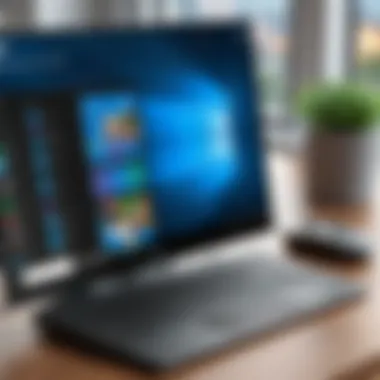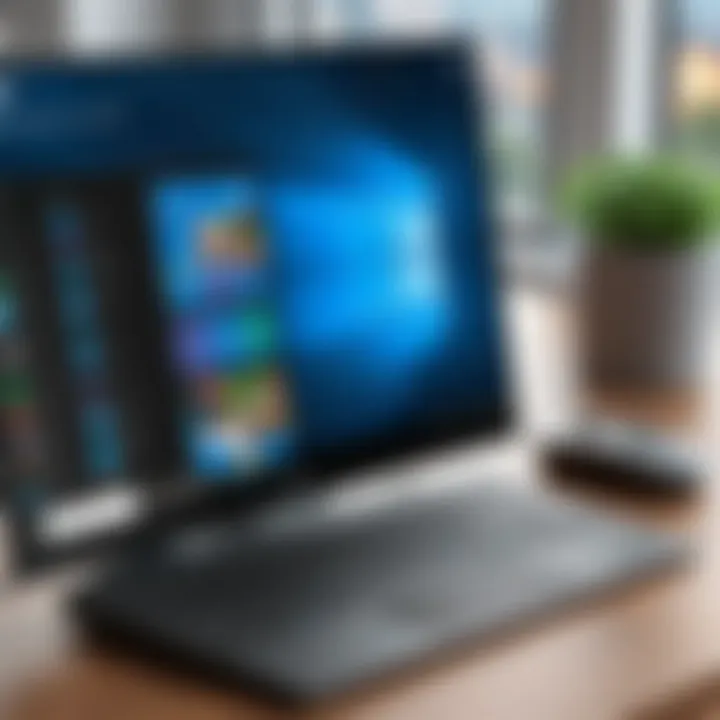Mastering Remote Desktop Connection on Windows 10


Intro
With an increase in remote work and a growing need for flexible computing environments, Remote Desktop Connection in Windows 10 has emerged as a critical tool. It allows users to connect and control their computers from remote locations, blurring the lines of traditional office setups. This guide aims to unravel the complexities surrounding Remote Desktop Connection, from its setup to its implications on security and productivity.
By understanding the nuances of remote desktop setups, users can fundamentally enhance their work efficiency. For IT professionals and ambitious tech enthusiasts, mastering Remote Desktop Connection is more than just a skill; it is a robust tool that opens new doors for managing and troubleshooting systems remotely.
Overview of Hardware/Software
Preface to Remote Desktop Connection
Remote Desktop Connection (RDC) is a built-in feature in Windows 10 that allows users to remotely connect to another computer over a network connection. It acts like a window into the other machine, letting you interact as if you were sitting at that computer. This tool is essential for various situations, such as accessing work files from home or managing servers without being physically present.
Key Features of Remote Desktop Connection
- Multi-session Capability: Connect to multiple computers simultaneously, enhancing team collaboration.
- Session Management: Allow disconnection and reconnection without losing work.
- Clipboard Synchronization: Copy and paste between your local and remote computer.
- Drive Mapping: Access local drives on the remote computer.
Specifications and Technical Details
RDC is compatible with Windows versions from Windows XP Professional onwards but offers the most optimizations in Windows 10. It requires:
- Operating System: Windows 10 Pro, Enterprise, or Education editions for host machine.
- Network Connection: Requires a stable internet connection for seamless operations.
- Local Firewall Settings: Configure firewall settings to allow Remote Desktop traffic.
Pricing and Availability
The Remote Desktop Connection client is free with Windows 10, but host access requires a Pro or higher version, which may implicate additional licensing or upgrade costs if coming from a Home version.
Comparison to Previous Versions
Compared to Windows 7 and 8, Windows 10 RDC features improved connection speeds, an updated user interface, and more robust security options. Users transitioning from earlier versions might find the enhancements in connectivity impressive, especially the ease of setup.
Pros and Cons
Strengths
- Convenience: Access your machine from anywhere, enhancing flexibility.
- Productivity: Less time wasted traveling to workstations.
- Support: Provides excellent support for IT help desks aiding clients remotely.
Weaknesses
- Latency Issues: Can be slow if internet speed is poor.
- Security Risks: Vulnerable to various attacks if not configured correctly.
User Feedback
User reviews often highlight RDC’s effectiveness in professional environments, where convenience trumps latency concerns. However, some express frustration with the setup process, particularly about firewall configurations.
Performance and User Experience
Performance Testing Results
Users have noted that performance can vary based on network conditions. Conducting tests on various connections, a stable Ethernet connection has yielded notable performance, while Wi-Fi often introduces delays.
User Interface and Ease of Use
The interface remains generally user-friendly. The most critical feature is the simple connection dialogue that allows users to easily input IP addresses and credentials.
Real-World Usage Scenarios
- IT Support: Tech support teams seamlessly troubleshoot client machines without being physically present, enabling a faster service response.
- Remote Work: Employees access office PCs to work on documents and applications as if at their desks.
Impact on Efficiency and Productivity
The ability to connect across distances can lead to significant productivity gains. Many find that they can handle tasks quickly from various locations, which reduces the load on physical office resources.
Recommendations and Culmination
Overall Verdict
Remote Desktop Connection is a powerful and necessary tool in today's distributed work environments. While it has its limitations, the advantages far outweigh the drawbacks when it’s correctly utilized.
Target Audience Suitability
This guide is tailored to IT professionals, organization administrators, and remote workers who require robust remote access capabilities.
Final Thoughts


As remote work continues to trend upward, investing time to fully understand and optimize Remote Desktop Connection will be an invaluable asset for individual users and organizations. Looking forward, keeping abreast of innovations and security practices will ensure that this critical tool remains safe and efficient.
Prolusion to Remote Desktop Connection
In today's fast-paced world, the notion of working from remote locations has become more prevalent than ever. No longer are we tied to a single desk or location to be productive. This shift makes understanding Remote Desktop Connection crucial for both IT professionals and tech aficionados alike. It opens doors to flexible work environments, enabling instant access to systems and data from anywhere with an adequate internet connection.
By diving into Remote Desktop Connection, we uncover a powerful tool that not only enhances workflow but also fosters collaboration among teams scattered across various locations. It’s like having a virtual office at your fingertips—whether you’re lounging at home or traveling across the globe. With the right setup, you can tap into your work computer as if you were sitting right in front of it, making the transition from in-office to remote work seamless.
Definition and Purpose
Remote Desktop Connection is fundamentally about bridging distances, allowing users to connect to another computer over a network. Through this technology, users can interact as if they were physically present. The purpose? To enhance accessibility and productivity. IT departments find it especially beneficial for troubleshooting issues on remote machines without needing to physically visit each unit. This capability significantly decreases downtime and maintains operational efficiency.
"Remote Desktop Connection eliminates physical barriers and enables seamless operations, making work as fluid as water."
This technology is also indispensable in environments where multiple team members need to collaborate on projects, facilitating real-time inputs and changes from different locations. Indeed, when set up effectively, Remote Desktop can act as a catalyst, transforming how businesses operate and respond to the demands of modern work-life balance.
Historical Context
The evolution of Remote Desktop Connection has its roots in the early days of computing. Initially, connecting remotely was a cumbersome task, requiring complicated setups and often expensive hardware. The introduction of the Remote Desktop Protocol (RDP) paralleled advancements in networking technologies during the 1990s, paving the way for broader use. With the rise of the internet and broadband connections, remote access began to blossom.
Fast forward to the 2000s, Microsoft incorporated RDP into Windows operating systems, making Remote Desktop Connection available to a broader audience. It didn’t take long for businesses to recognize its utility, and as organizations shifted towards globalization, the need for remote access became even more pronounced. Today, practically every sector—from tech startups to multinational corporations—utilizes Remote Desktop in some form, adapting the technology to fit their unique needs. In this sense, understanding its trajectory enriches our appreciation of how critical it has become to contemporary business practices.
Setting Up Remote Desktop Connection
Setting up Remote Desktop Connection is a critical step for anyone looking to navigate the complex world of remote work and access. It serves as the gateway to managing machines from afar, doing away with the need to be physically present at the workstation. We can’t underestimate the importance of setting this up correctly; it helps in various scenarios, whether you're providing tech support, accessing files from afar, or managing servers. In today’s work environment where mobility is king, understanding how to correctly set up this connection can save both time and hassle.
System Requirements
Before diving into the setup, ensure that your systems meet the necessary requirements for Remote Desktop Connection to function smoothly. First and foremost, you need a compatible version of Windows 10. Remote Desktop requires the Pro, Enterprise, or Education edition on the machine you wish to access remotely. Home editions do not support hosting Remote Desktop connections.
In addition to the operating system specifics, here's a checklist:
- Processor: 1.0 GHz or faster processor
- RAM: Minimum of 2 GB RAM
- Network: Reliable broadband Internet connection
- VPN Configuration: If working remotely over a connection outside your local network, proper VPN setup might be necessary.
If these conditions are met, you're ready for the next step.
Enabling Remote Desktop
To enable Remote Desktop on your Windows 10 machine, follow these simple steps:
- Open Settings from the Start menu.
- Navigate to System and then select Remote Desktop.
- Toggle the switch to enable Remote Desktop.
- You may want to click on Advanced settings to adjust your connection settings properly. Here, you can choose whether to allow connections only with network-level authentication, which enhances security.
Enabling Remote Desktop is essential for allowing connections, but remember, it’s not a set-it-and-forget-it feature; you should regularly review your connection settings to ensure they meet your security needs.
It's important to note that enabling Remote Desktop will automatically open a firewall port. So if you’re working in a secure environment, be sure to confirm that your organization’s firewall settings allow this traffic.
Configuring Network Settings
If you want your Remote Desktop Connection to work fluidly, you need to configure network settings properly. This includes static IP addressing and router settings. A dynamic IP address can change, resulting in connection issues when accessing remotely.
- Assigning a Static IP Address: First, ensure that the remote machine has a static IP. You can set this in your router’s interface or directly on the device.
- Port Forwarding: If you are working from outside your local network, consider setting up port forwarding on your router. Forward TCP port 3389 to the IP address of the machine you're trying to reach. That way, external requests for Remote Desktop are handled correctly.
- Testing the Connection: Once everything is set up, test your connection via an external network to ensure that it’s working properly. Monitoring the connection and making real-time adjustments based on your findings can improve your performance and resolve potential issues before they become significant problems.
Setting up Remote Desktop Connections may seem daunting at first, but by following these structured paths — understanding system requirements, enabling the feature, and configuring your network settings — you pave the way for a seamless remote experience.
Connecting to Remote Desktop
In the age of increased connectivity, understanding how to connect to Remote Desktop is akin to mastering a vital skill for both personal and professional efficiencies. This approach allows users to access and control another computer remotely, offering flexibility and streamlined workflows. It isn’t just a matter of convenience; it’s about optimizing your work environment, whether you’re managing tasks from your office computer at home or accessing essential files while on the go.
The process essentially transforms the way we think about work, enabling seamless interactions between devices. Through Remote Desktop, users can run applications, access files, and control settings as if they were sitting right in front of the remote machine. This is particularly important for IT professionals who need to manage systems without the need for physical presence.
Accessing Remote Desktop from Windows
Accessing Remote Desktop from Windows is a straightforward process, yet it is key in harnessing the full potential of this technology. By using the built-in Remote Desktop Connection client, users can quickly establish a connection to other Windows machines. To initiate this:
- Begin by searching for "Remote Desktop Connection" in the Windows Start Menu.
- Open the application and you will find a dialog box asking for the computer name or IP address of the target machine.
- Enter the details and click "Connect".
This instant access allows for real-time reactions to any issues that may arise on the remote system. Moreover, with the ability to use shared resources, it enables smoother transitions and adaptation to remote workflows. Whether you're troubleshooting a problem or providing training, being able to access desktops remotely saves both time and effort.
Remember: Networking configurations must be set properly beforehand. Ensure that the correct firewall settings are in place.
Using Remote Desktop from Other Devices
Using Remote Desktop extends beyond just Windows machines. The ability to connect from other devices opens a new world of possibilities. Users can access their Windows desktops from various platforms—be it macOS, iOS, or even Android devices. With this flexibility, employees can work from virtually anywhere, creating a highly adaptable work culture.


To connect from a non-Windows device, follow these basic steps:
- Install the Remote Desktop application specific to your device’s operating system. For instance, if you’re using an iPad, download the Microsoft Remote Desktop app from the App Store.
- Open the app and input the necessary connection details similar to the Windows client.
- Tap "Connect" and voilà, you’re in!
This adaptability is especially crucial for remote teams or individuals who travel often, ensuring that productivity does not wane outside of the traditional office environment. However, it’s essential to remain vigilant about security protocols when connecting across devices, as this could expose sensitive information to potential risks.
Understanding the intricacies of connecting to Remote Desktop across various systems not only enhances workflow but also amplifies collaborative efforts in today's digital workspace. Embracing this technology can lead to increased efficiency, better problem-solving, and improved communication among team members.
Troubleshooting Connection Issues
In the realm of remote desktop connections, encountering issues is not just a possibility—it's almost a certainty at some point. Hence, understanding how to troubleshoot connection problems is paramount. This section will explore common problems and provide clear guidance on resolving these issues, ensuring you can regain access swiftly and effectively.
Common Connection Problems
Remote Desktop Connection is a powerful tool, but it comes with its quirks. Here are some typical problems that users often face:
- Network Issues: The connection might drop if the network is unstable or, worse yet, if you are disconnected from Wi-Fi altogether.
- Firewall Restrictions: Sometimes, the protective barriers like firewalls might block remote connections, causing frustration.
- IP Address Confusion: If multiple devices vie for the same IP address or if the server's IP address has changed, you might find yourself knocking at a closed door.
- Service Not Running: If the Remote Desktop Service isn't running on the host machine, it's like trying to call a number that's out of service.
- Authentication Problems: Incorrect usernames or passwords are classic hurdles that can derail your connection attempt.
The importance of identifying these problems quickly cannot be overstated, especially in critical environments where immediate access to systems is essential.
Steps to Resolve Key Issues
Solving these problems requires a methodical approach. Below are steps to take when faced with connection obstacles:
- Check Network Connectivity: Make sure the connection to the local network is stable. Use commands like or check other devices to confirm connectivity.
- Review Firewall Settings: Inspect your firewall settings to ensure they allow Remote Desktop Connection. It's often easier than it sounds.
- Verify the IP Address: Confirm that you're entering the correct IP address. You can find this by using in the command prompt on the host machine.
- Start Remote Desktop Services: To check if the necessary services are running:
- Double-check Your Credentials: Authentication issues often arise from simple errors. Re-enter your username and password carefully, ensuring you match the case.
- On Windows, search for "Windows Firewall" in the start menu and navigate to "Allowed apps."
- Ensure that Remote Desktop is checked.
- Press , type , and hit Enter.
- Look for "Remote Desktop Services" and ensure it's running.
By following these steps, many users can restore their connection without needing extensive technical support. Regularly running through these checks can save time and prevent future access headaches.
Remember, a proactive approach can often mitigate potential separation from your system.
In summary, while troubleshooting remote desktop connections can seem daunting at first, familiarizing oneself with common issues and their resolutions can greatly reduce downtime and enhance productivity. Proper preparation and a calm mindset go a long way in resolving these problems efficiently.
Pros and Cons of Remote Desktop
Understanding the pros and cons of Remote Desktop is essential in navigating the waters of modern technology. For IT professionals and tech enthusiasts, recognizing both the strengths and the potential drawbacks of this tool can make all the difference in efficient operations and informed decisions.
Advantages of Remote Access
Remote Desktop Connection offers various benefits that can enhance productivity and flexibility in professional environments. Here are some of the primary advantages:
- Access from Anywhere: Users can reach their desktop from virtually any location with an internet connection. This opens up new avenues for remote work and collaboration, making it easier for teams spread across different geographical areas to work together seamlessly.
- Cost-Efficiency: For businesses, utilizing Remote Desktop could lead to significant savings. With the ability to access a work computer without needing high-end hardware for each employee, companies can optimize their technology spend.
- Centralized Management: When using Remote Desktop, IT departments can manage systems more effectively. They can troubleshoot issues, install updates, and provide support without needing to be physically present, enhancing the overall efficiency of operations.
- Resource Sharing: Remote Desktop enables users to share resources such as printers and files effortlessly. This is particularly advantageous in environments where multiple users require access to the same devices or information.
"In a world where adaptability is key, Remote Desktop provides the tools needed to stay connected despite physical barriers."
Potential Limitations
While the benefits of Remote Desktop Connection are clear, it’s also critical to weigh its limitations. Here are a few notable concerns:
- Security Risks: Remote connections can expose systems to potential cyber threats. Without proper configurations and strong security protocols, sensitive data could become vulnerable.
- Dependence on Internet Connectivity: A stable internet connection is essential for effective remote access. Any disruption in service can lead to downtime, frustrating users and hampering productivity.
- Limited Functionality for Graphic-Intensive Applications: For tasks requiring high graphical performance, Remote Desktop may not meet the required standards. Users engaging in graphic design or video editing may find the performance lagging compared to local setups.
- Licensing Costs: Depending on the scale of deployment, licensing for Remote Desktop services might involve additional costs. Organizations need to consider whether the benefits outweigh these fees based on their usage needs.
Security Considerations
When it comes to Remote Desktop Connection, ensuring robust security measures is nothing short of critical. With increasing connectivity and reliance on digital platforms, the risks associated with remote access are ever-present. This section dives into two pivotal aspects of securing your remote desktop environments: the importance of strong passwords and the necessity of utilizing Virtual Private Networks (VPNs). A secure setup not only protects sensitive data but also builds trust with the users and stakeholders who rely on these systems.
Importance of Strong Passwords
A strong password is like a sturdy lock on your front door. Without it, you’re leaving your digital home wide open for intruders. Here are a few key points to consider:
- Complexity Matters: Passwords that mix letters (both upper and lower case), numbers, and special characters create a far more formidable barrier against unauthorized access. Using common words or predictable patterns is a recipe for disaster.
- Length is Key: Aim for passwords that are at least 12-16 characters long. While it may be tempting to stick to shorter ones for convenience, the more characters you add, the tougher it becomes for hackers to crack it.
- Regular Updates: Stale passwords are often an easy target. Changing passwords regularly, perhaps every few months, can significantly bolster your security. Even better, avoid using the same password across different platforms; it’s one thing to lose access to one account, and quite another to endanger all accounts with interconnected logins.
- Enable Multi-Factor Authentication: When available, activate multi-factor authentication (MFA). This adds another layer of security, requiring not just a password but also a second form of verification, like a text message or an authentication app.
"A strong password is the first line of defense against intrusions; don’t underestimate its power."
Utilizing VPN for Security
Virtual Private Networks (VPNs) are another layer of protection that can fortify your Remote Desktop Connection. Here’s why you should consider using a VPN:
- Encryption of Data: A VPN encrypts your internet connection, shielding your data from prying eyes. This is especially vital when accessing a remote computer over public Wi-Fi, where unsecured connections are rampant.
- Anonymity and IP Masking: By connecting through a VPN, your real IP address is hidden. This not only adds a veil of privacy but also hinders cyber attackers from pinpointing your actual location, adding another obstacle for them to overcome.
- Preventing ISP Monitoring: Some ISPs track your browsing habits and may throttle your bandwidth if they detect heavy usage. With a VPN, your online movements remain private, reducing the chance of ISPs interfering with your connection speeds.
- Safer Collaboration: Companies that allow remote work can rest easier knowing their employees are accessing company networks through secure channels, which reduces the risk of data breaches.
In summary, ensuring the security of your Remote Desktop Connection is not just a recommendation—it's essential. Strong passwords and the use of VPNs create a compelling defense against a variety of cyber threats, providing a secure digital workspace. Embracing these practices is a wise move for anyone involved in remote access, be it IT professionals, tech enthusiasts, or everyday users.


Remote Desktop Alternatives
In today’s fast-paced technological landscape, relying solely on Remote Desktop Connection within Windows 10 might not be enough for everyone. Various alternatives cater to diverse needs, providing functionality that the default settings might lack. Exploring these options is paramount as they offer specific features, like cross-platform support or user-friendly interfaces, that enhance remote access capabilities. Businesses and individual users alike stand to benefit from understanding these alternatives, especially in terms of flexibility and enhanced security.
Exploring Third-party Solutions
Numerous third-party applications serve as viable alternatives to Windows' built-in Remote Desktop. The beauty of these solutions lies in their adaptability and special features that cater to distinct user requirements. For instance:
- TeamViewer: Renowned for its collaboration capabilities, TeamViewer excels in facilitating remote access without the hassle of complex configurations.
- AnyDesk: This software prides itself on low latency and high responsiveness, a necessity for graphic-intensive tasks.
- LogMeIn: Offers advanced file sharing and comprehensive remote management tools suited for professionals.
Selecting the right tool demands attention to detail. Users should evaluate considerations such as ease of use, customer support, and additional features. Some tools excel in security, while others shine in speed or user interface. It's always a balancing act between convenience and capability.
Comparative Analysis of Tools
To help decide which remote access solution fits best, consider the following comparative elements:
- Performance: Analyze connection speed and latency differences among tools. Solutions like AnyDesk might outshine others in terms of speed.
- Security: Security protocols vary widely. TeamViewer, for example, provides end-to-end encryption, which is crucial for sensitive data.
- Cost: While some tools offer free versions, others come with a price. LogMeIn often caters more to businesses and might demand a subscription.
Here’s a summary for quick reference:
| Tool | Performance | Security | Cost | | TeamViewer | High | End-to-end encryption | Free/Premium | | AnyDesk | Very High | Strong encryption | Freemium | | LogMeIn | Moderate | Advanced features | Subscription |
Case Studies
In the realm of technology, particularly when discussing Remote Desktop Connection in Windows 10, the inclusion of case studies serves as a powerful lens through which to view the practical implications and successes of remote access applications. These case studies not only highlight the real-world utilizations but also lay the groundwork for learning from past experiences.
Examining various case studies can provide invaluable insight into how organizations and individuals have successfully implemented remote desktop solutions. They underline the specific scenarios where these technologies have excelled and identify potential pitfalls that others might encounter. This real-world context enriches theoretical understanding and helps demystify complex concepts for IT professionals and enthusiasts alike.
There's a vital aspect of learning that comes from observing successes and failures. This article will delve into both practical case studies—those that exemplify best practices—and cautionary tales that illustrate the challenges one can face when setting up and maintaining remote connections.
Real-world Applications
Remote Desktop technology has found its wings in various sectors, each with its own unique applications and outcomes. For instance:
- Healthcare: A healthcare provider may utilize Remote Desktop to allow doctors to access patient records securely from home. This flexibility can significantly enhance productivity, especially when there's a need for quick access to vital information.
- Education: Schools have adapted remote desktop tools to facilitate online learning environments, allowing students to access educational resources from their own devices. Studies in this sector have noted improved engagement, making it easier for educators to manage their courses effectively.
- Corporate Use: Companies often implement Remote Desktop services to enable employees to work from remote locations, which can lead to increased job satisfaction and productivity. A notable example is a tech firm that allowed its developers to connect from various international sites, leading to an impressive increase in project outputs without sacrificing security.
These examples illustrate how Remote Desktop Connection can be a boon, not just for immediate access needs, but as a strategic enabler in various sectors.
Lessons Learned from Implementations
When businesses or organizations tread into the world of Remote Desktop technology, there are always lessons to be gleaned from their journeys.
- Emphasis on Training: In a case where a financial institution launched Remote Desktop services without adequate training, they stumbled upon security breaches. Proper training ensured employees could effectively use the feature while safeguarding sensitive client data.
- Network Preparedness: A retail chain discovered that insufficient bandwidth could hinder performance. An upgrade before implementation turned out to be a pivotal decision that boosted efficiency across all locations rather than just painlessly connecting a few users.
- Security Protocols: A small business faced a potential crisis when they opted not to use a VPN for remote connections. Following a security breach, they learned that implementing robust security measures was not just an option, but a necessity to safeguard sensitive data.
- Regular Maintenance: One large organization found themselves in a quagmire due to ignoring routine system maintenance. They learned that keeping systems updated not only enhances performance but also fortifies against vulnerabilities.
Even the most sophisticated solutions must be backed by diligent oversight and proactive practices. Through these lessons, IT professionals can better navigate the complexities of remote access technologies, ensuring that their implementations are both effective and secure.
In summary, case studies serve as a crucial resource, illuminating the ways remote desktop technology has been applied universally. By learning from both achievements and setbacks, professionals can formulate strategies that pave the way for future successes.
Future Trends in Remote Access Technology
As remote work becomes the new norm, understanding the emerging trends in remote access technology advocates for an informed approach among IT professionals and tech enthusiasts. Not only do these advancements facilitate better connectivity, but they also elevate the user experience significantly. With an ever-increasing emphasis on productivity and security, it's essential to keep a finger on the pulse of these innovations.
Emerging Technologies
In the landscape of remote access, a few technologies stand out, ready to rip the cover off traditional barriers. Here are key players to watch:
- Cloud-Based Solutions: The shift towards cloud technology allows users to access their desktops from virtually anywhere, using just an internet connection. This means personalizing the workspace to cater to various needs can be done with ease.
- AI and Machine Learning: Artificial intelligence is becoming more embedded in remote desktop solutions. This tech can optimize bandwidth usage by predicting user behavior and reducing latency, enhancing the overall experience.
- Virtual Reality (VR) and Augmented Reality (AR): Although still in its nascent stage, VR and AR have the potential to revolutionize remote work. Imagine conducting team meetings in a virtual room, where everyone's presence is felt as if they were sitting across the table. This could break down the emotional barriers often present in remote communication.
The development of these technologies speaks volumes about the potential future of remote access tools. They not only simplify daily tasks but also tackle long-standing issues of connectivity and engagement.
Potential Developments
Looking ahead, there are crucial considerations and developments likely to shape the future of remote desktop access:
- Increased Focus on Cybersecurity: As remote access expands, the risk of cyber threats escalates. Future solutions must integrate advanced encryption and multi-factor authentication methods to mitigate these threats effectively.
- Interoperability Among Platforms: Users often navigate multiple applications concurrently. Ensuring seamless interaction between different platforms will be a game changer. Developments will prioritize integrations to enhance user experiences across various tools and environments.
- User-Centric Design: As accessibility becomes vital, future remote desktop solutions will be tailored to meet various user needs. This means simplified interfaces that prioritize intuitive design, ensuring even the less tech-savvy can harness remote access capabilities.
The ability of businesses to adapt their remote desktop technologies will be crucial. The rapid pace of change will demand not only initial implementation but also continual evolution.
Staying updated on these trends is not just beneficial. It’s critical to maintaining a competitive edge in the technology landscape. By understanding where remote access technology is heading, professionals can better prepare and strategize for the future. The way we interact, collaborate and share resources in an online world is ever-evolving, with endless possibilities on the horizon.
End
In wrapping up the intricate world of Remote Desktop Connection in Windows 10, it is essential to understand just how pivotal this technology can be for both personal and professional use. The ability to remotely access a computer not only bridges the gap between physical locations but also enhances flexibility and productivity. For many IT professionals and tech enthusiasts, mastering this tool can lead to smoother operational flows and improved troubleshooting capabilities.
Recap of Key Points
- Functionality: Remote Desktop Connection enables users to access and manage their desktops from varying locations, which significantly boosts efficiency.
- Configuration: Setting up this connection requires specific steps, such as enabling the feature and configuring network settings, ensuring a seamless experience.
- Security: As with any technology that connects devices, security is paramount. Using strong passwords and leveraging VPNs are essential practices to safeguard data.
- Alternatives and Innovations: While Remote Desktop Connection is robust, exploring other solutions can offer unique benefits suited to different needs. Keeping an eye on future trends ensures that one remains ahead in the rapidly evolving tech landscape.
Final Thoughts
Navigating the realm of Remote Desktop Connection is not merely about understanding the "how-to" but also grasping the implications and possibilities this technology presents. As we look forward, the importance of efficient remote access solutions cannot be overstated. Whether for remote work or IT management, having a solid grasp on these tools empowers users to tackle challenges head-on. Embracing both the advantages and limitations of remote desktop technologies prepares us not just to leverage them but to innovate and adapt as technologies continue to advance. In an ever-changing digital world, staying informed and flexible remains the best strategy.



